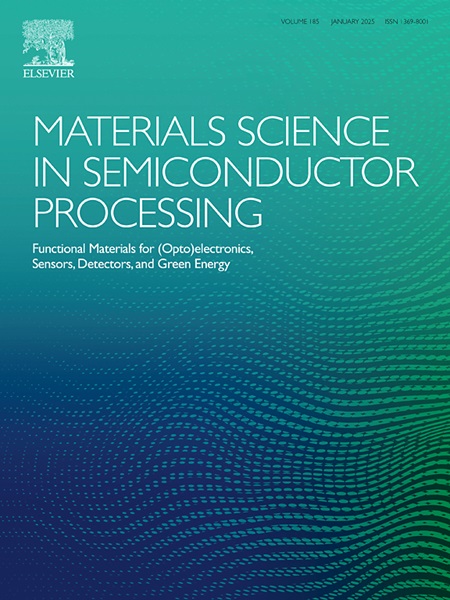Dislocation characterization of GaN layers in high-performance, High-Electron-Mobility Transistor structures grown on on-axis and off-axis 4H-SiC(0001) substrates
IF 4.6
3区 工程技术
Q2 ENGINEERING, ELECTRICAL & ELECTRONIC
引用次数: 0
Abstract
Controlling the dislocation behavior in component layers is critical for fabricating high-performance, high-electron-mobility transistor (HEMT) devices. The dislocation characteristics in the gallium nitride (GaN) layers of HEMT structures grown on on-axis and off-axis 4H-SiC substrates via molecular beam epitaxy were studied using various X-ray diffraction (XRD) and transmission electron microscopy (TEM) techniques. By employing high-resolution XRD and two-beam bright-field TEM images, the dislocation densities could be quantitatively analyzed, and the type of dislocations was identified in the GaN layers; the dislocation density on the off-axis substrate was higher than that on the on-axis substrate under the same deposition conditions, with a relative increase in the screw- and mixed-type dislocations identified in the GaN layer on the off-axis substrate. The evolution of screw- and mixed-type dislocations in an AlN buffer layer was also evident on the off-axis 4H-SiC substrate. Finally, the origin of the screw- and mixed-type dislocations was briefly demonstrated based on the atomic structures of the surface step of the off-axis 4H-SiC substrate. These findings provide valuable insights into the dislocation dynamics in GaN layers grown onto misoriented SiC substrates, contributing to the global effort to achieve superior HEMT performance through the optimization of epitaxial growth strategies.

在轴向和离轴4H-SiC(0001)衬底上生长的高性能、高电子迁移率晶体管结构中GaN层的位错表征
控制元件层中的位错行为是制造高性能、高电子迁移率晶体管(HEMT)器件的关键。利用x射线衍射(XRD)和透射电子显微镜(TEM)研究了分子束外延生长在轴向和离轴4H-SiC衬底上的氮化镓(GaN)结构层中的位错特征。利用高分辨率XRD和双光束亮场TEM图像,定量分析了氮化镓层中的位错密度,并确定了位错类型;在相同沉积条件下,离轴衬底上的位错密度高于在轴衬底上的位错密度,离轴衬底上的GaN层中螺旋型和混合型位错相对增加。在离轴4H-SiC衬底上,AlN缓冲层中螺旋型和混合型位错的演变也很明显。最后,基于离轴4H-SiC衬底表面台阶的原子结构,简要论证了螺旋型位错和混合型位错的成因。这些发现为在错取向SiC衬底上生长的GaN层中的位错动力学提供了有价值的见解,有助于通过优化外延生长策略实现卓越的HEMT性能。
本文章由计算机程序翻译,如有差异,请以英文原文为准。
求助全文
约1分钟内获得全文
求助全文
来源期刊

Materials Science in Semiconductor Processing
工程技术-材料科学:综合
CiteScore
8.00
自引率
4.90%
发文量
780
审稿时长
42 days
期刊介绍:
Materials Science in Semiconductor Processing provides a unique forum for the discussion of novel processing, applications and theoretical studies of functional materials and devices for (opto)electronics, sensors, detectors, biotechnology and green energy.
Each issue will aim to provide a snapshot of current insights, new achievements, breakthroughs and future trends in such diverse fields as microelectronics, energy conversion and storage, communications, biotechnology, (photo)catalysis, nano- and thin-film technology, hybrid and composite materials, chemical processing, vapor-phase deposition, device fabrication, and modelling, which are the backbone of advanced semiconductor processing and applications.
Coverage will include: advanced lithography for submicron devices; etching and related topics; ion implantation; damage evolution and related issues; plasma and thermal CVD; rapid thermal processing; advanced metallization and interconnect schemes; thin dielectric layers, oxidation; sol-gel processing; chemical bath and (electro)chemical deposition; compound semiconductor processing; new non-oxide materials and their applications; (macro)molecular and hybrid materials; molecular dynamics, ab-initio methods, Monte Carlo, etc.; new materials and processes for discrete and integrated circuits; magnetic materials and spintronics; heterostructures and quantum devices; engineering of the electrical and optical properties of semiconductors; crystal growth mechanisms; reliability, defect density, intrinsic impurities and defects.
 求助内容:
求助内容: 应助结果提醒方式:
应助结果提醒方式:


